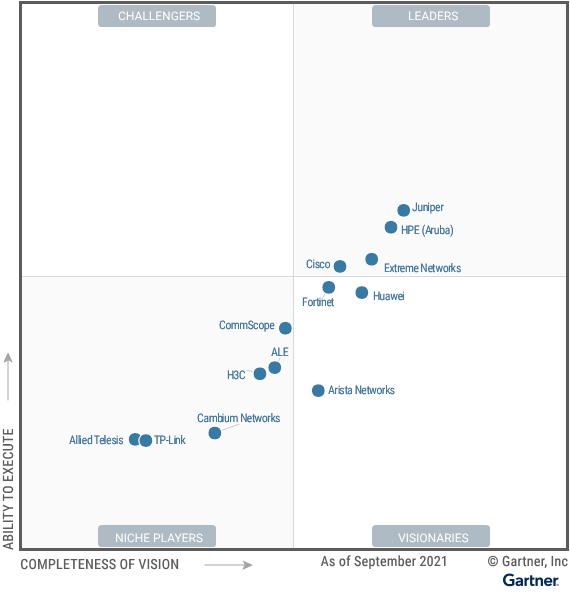Juniper, HPE, Extreme, Cisco Lead Gartner LAN Infrastructure Magic Quadrant
Most customers are buying network infrastructure from channel partners and on a one-time basis.

Juniper Networks, HPE (Aruba), Extreme Networks and Cisco continue to lead Gartner‘s Magic Quadrant for wired and wireless LAN infrastructure.
The market research firm’s leaderboard features all four companies reprising their spots in last year’s “Leaders” quadrant. Juniper stands just a tad ahead of its peers, earning praise from Gartner for the artificial intelligence, machine learning and automation it has built into its offerings.

Gartner Wired and Wireless LAN Infrastructure Magic Quadrant
While Juniper’s acquisition of Mist Systems helped upgrade its solutions, Gartner analysts said they will be watching to see how the companies mesh with one another.
“Mist’s technology-forward culture continues to be integrated into the larger Juniper culture. Such integrations can be disruptive to both internal business units and to the end user. Both Juniper and its customers must monitor and manage this transition carefully,” the report authors said.
The Gartner report shows the important role the indirect sales channel plays in the success of each company. For example, Gartner praised Cisco’s channel ecosystem, which “address and support enterprise presales engineering and procurement requirements, irrespective of location.” On the other hand, it said Extreme Networks customers report confusion around channel and product demonstrations.
Arista made a step forward by joining Fortinet and Huawei in the “Visionaries” quadrant. Gartner noted that the vendor’s “limited channel and sales resources” was limiting its international growth, despite offering an advanced technology stack.
For a sixth consecutive year, no companies landed in the “Challengers” quadrant.
Details
Gartner did not add any vendors to the quadrant in 2021, but it did drop five: D-Link, Dell, Ubiquiti Networks, Rhode & Schwartz and Ruijie Networks. The first three failed to meet inclusion criteria, while the latter two failed to meet revenue requirements. No one country could account for 55% of applicant’s revenue.
Gartner determined the quadrant through 1,500-plus client interactions and other research over the last year.
Gartner noted that incumbent enterprise network vendors maintain customer relationships at a high rate due to a “relatively conservative and risk-averse” market. Many customers don’t want to deal with the “high costs” of switching vendors.
“Organizations tend to stay with their current enterprise network vendor if it offers a technology portfolio that is ‘good enough’ to fit its needs and functions within reasonable expectations,” the report said
Trends
Gartner noted that customers typically get their LAN infrastructure through authorized channel partners. In addition, they typically consume the offerings through a small amount of one-time purchases.
Gartner also wrote that the commoditization of network hardware continues to ramp up. With that in mind, vendors are seeking to differentiate themselves through software.
“However, as network vendors adopt the stance of software vendors, there are diminishing options for traditional perpetual licensing. Vendors realize new revenue streams by shifting to subscription-based licensing, but the shift is often confusing and continues to be a source of frustration for I&O leaders,” the report authors said.
In addition, Gartner noted that many of its clients prefer to have a choice of licensing options.
The study found that one in four (25) enterprises that “align network operations plans to business-led objectives” are growing faster than their peers. However, that number is set to grow to 80% by 2024.
Gartner also found that microchip shortages are increasingly impacting the purchasing process for network hardware. According to Gartner, lead times for network hardware purchases last from one month to beyond six..
“Organizations are mitigating these long lead times by anticipating disruptions and ordering critical network equipment sooner than required or temporarily pushing noncritical projects out over the short term and midterm,” the authors said.
About the Author(s)
You May Also Like


